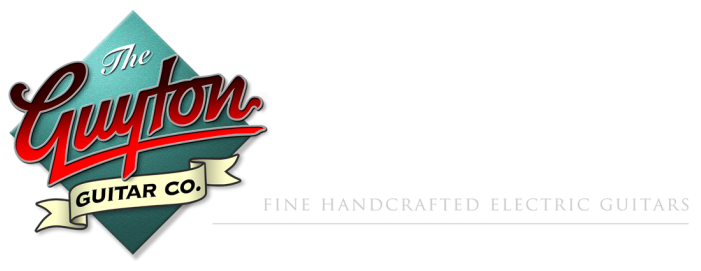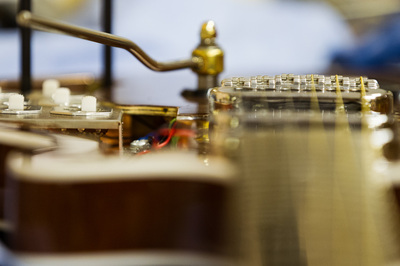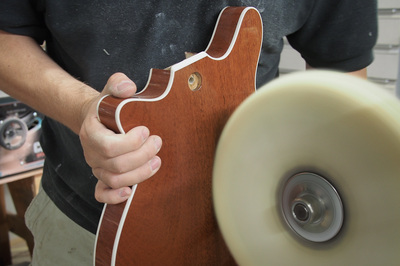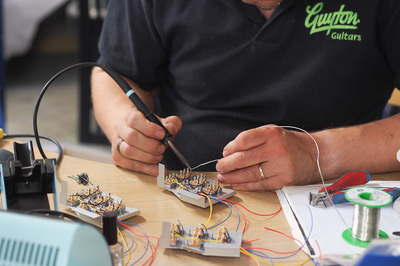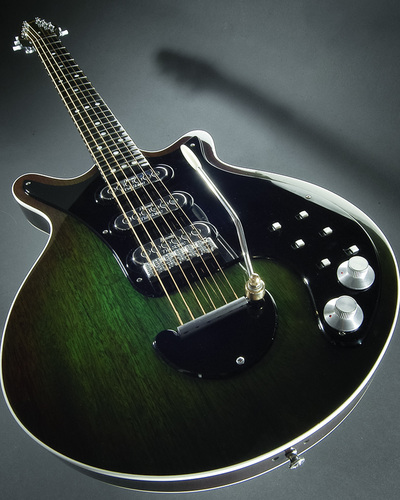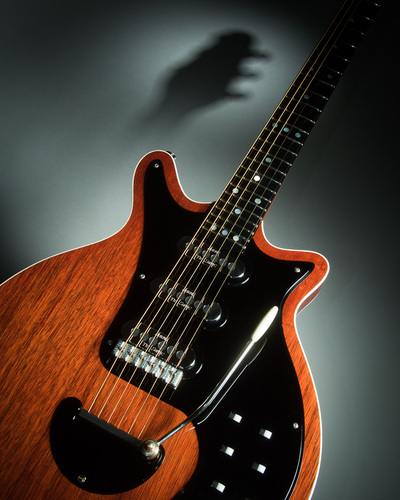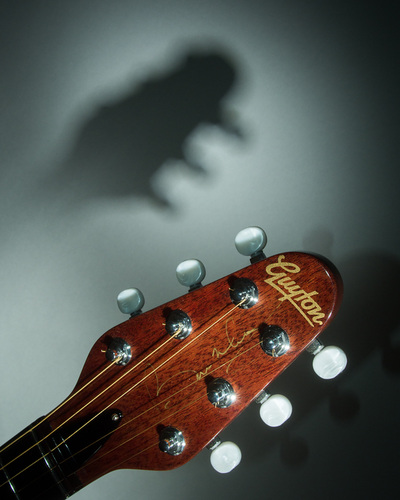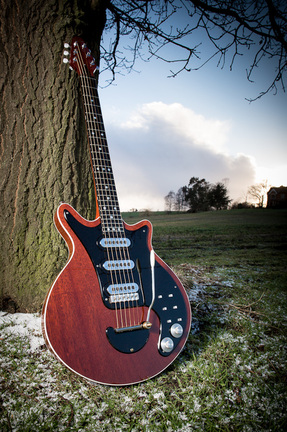
The story of the Guyton Red Special
In June 2003, on the back of restoration work I had carried for Brian, I was asked by Pete Malandrone whether I'd be interested in making authentic replicas of the famed Red Special. As opportunities like this happen literally once in a lifetime, I agreed, and with Brian's full consent, we set a date when I should return to measure and photograph the original guitar.
Early August saw me return to Brian’s home for an intensive two days of measuring, examining and photographing the ‘Red Special’. At first this was incredibly nerve racking, not only had this guitar featured on some of the worlds best loved and revered music, but it was the only one of it’s kind, making it the rarest, and possibly one of the most valuable guitars in the world. But with Petes help, I soon settled into the task in hand.
After two days of work, I was confident I had enough information to construct my own replica. Armed with this information, I set about drawing every part. This took a considerable amount of time, not only did all the parts have to look right they also had to work together in the correct manner. But still, one thing was missing… one thing that no matter how many measurements and photos I took, I could not get, and that was the size and shape of the internal cavities, bearing in mind that Brian and his father Harold had designed these cavities so that they would give just the right amount of musical sustain and feedback.
This is where Pete stepped in and arranged for the guitar to be x-rayed at St.Barts hospital in London. With this new information. My aim was to make possibly the closest replica yet, not only had the x-rays shown the size and shape of the cavities, they also showed the method of securing the knife-edge and body/neck construction that simply hadn’t been available by general examination of the guitar.
Before I started the build of the guitars, Brian and Pete had said that this was to be a special limited edition, so we agreed on producing fifty guitars, forty in red, to commemorate it’s fortieth birthday, and a further ten in green, for no other reason that I had seen a green Guild BM, and thought it looked fabulous, so thought it might good to do the remaining ten in this colour.
With the drawings and spec complete, I set to work making the two planned prototypes. This generally went very well, but because of their complex construction, and having to employ techniques I was not familiar with, they did throw up the occasional challenge or two. By Christmas 2003, the bulk of the work was complete. The bodies and necks had been made and lacquered, all the parts had been machined, and all that was left to do was to polish the guitars and assemble them. With the guitars finally complete, it was time to pack the guitars away in their cases and gain Brians approval. So in the middle of January, and with public expectation weighing heavily on my shoulders, I took a trip to Brians for his first viewing of the two prototype guitars.
Brians first reaction was very positive, and generally he loved them, although there were a couple of small niggles to attend to, like pickup heights and tremolo spring rates. But all in all, it was a good day!
After a month or so, with all the adjustments and modifications in place, I visited Brian again, this time for an intensive testing of the new guitars, they were to be A-B’d with the real thing through Brian’s favourite Vox AC30 and Treble booster. This time Brian had the whole afternoon free, so he could relax and take his time examining the prototypes. With Pete manning the A/B switch, Brian set to work, and left no stone unturned. Both guitars were given a thorough going over, and were constantly compared with the ‘Red Special’. After about three hours, the only change I was asked to make, was to lower the middle pickup half a millimetre, on the treble side!!...but it did make a difference, suddenly the sound just fell into place.
It was a great day, and one that I shall not forget in a hurry, after all.. it’s not every day that you get to sit next to one of Rock’n’Roll’s most influential guitarists, and watch his smile broaden while he plays a guitar you’ve actually built!
In June 2003, on the back of restoration work I had carried for Brian, I was asked by Pete Malandrone whether I'd be interested in making authentic replicas of the famed Red Special. As opportunities like this happen literally once in a lifetime, I agreed, and with Brian's full consent, we set a date when I should return to measure and photograph the original guitar.
Early August saw me return to Brian’s home for an intensive two days of measuring, examining and photographing the ‘Red Special’. At first this was incredibly nerve racking, not only had this guitar featured on some of the worlds best loved and revered music, but it was the only one of it’s kind, making it the rarest, and possibly one of the most valuable guitars in the world. But with Petes help, I soon settled into the task in hand.
After two days of work, I was confident I had enough information to construct my own replica. Armed with this information, I set about drawing every part. This took a considerable amount of time, not only did all the parts have to look right they also had to work together in the correct manner. But still, one thing was missing… one thing that no matter how many measurements and photos I took, I could not get, and that was the size and shape of the internal cavities, bearing in mind that Brian and his father Harold had designed these cavities so that they would give just the right amount of musical sustain and feedback.
This is where Pete stepped in and arranged for the guitar to be x-rayed at St.Barts hospital in London. With this new information. My aim was to make possibly the closest replica yet, not only had the x-rays shown the size and shape of the cavities, they also showed the method of securing the knife-edge and body/neck construction that simply hadn’t been available by general examination of the guitar.
Before I started the build of the guitars, Brian and Pete had said that this was to be a special limited edition, so we agreed on producing fifty guitars, forty in red, to commemorate it’s fortieth birthday, and a further ten in green, for no other reason that I had seen a green Guild BM, and thought it looked fabulous, so thought it might good to do the remaining ten in this colour.
With the drawings and spec complete, I set to work making the two planned prototypes. This generally went very well, but because of their complex construction, and having to employ techniques I was not familiar with, they did throw up the occasional challenge or two. By Christmas 2003, the bulk of the work was complete. The bodies and necks had been made and lacquered, all the parts had been machined, and all that was left to do was to polish the guitars and assemble them. With the guitars finally complete, it was time to pack the guitars away in their cases and gain Brians approval. So in the middle of January, and with public expectation weighing heavily on my shoulders, I took a trip to Brians for his first viewing of the two prototype guitars.
Brians first reaction was very positive, and generally he loved them, although there were a couple of small niggles to attend to, like pickup heights and tremolo spring rates. But all in all, it was a good day!
After a month or so, with all the adjustments and modifications in place, I visited Brian again, this time for an intensive testing of the new guitars, they were to be A-B’d with the real thing through Brian’s favourite Vox AC30 and Treble booster. This time Brian had the whole afternoon free, so he could relax and take his time examining the prototypes. With Pete manning the A/B switch, Brian set to work, and left no stone unturned. Both guitars were given a thorough going over, and were constantly compared with the ‘Red Special’. After about three hours, the only change I was asked to make, was to lower the middle pickup half a millimetre, on the treble side!!...but it did make a difference, suddenly the sound just fell into place.
It was a great day, and one that I shall not forget in a hurry, after all.. it’s not every day that you get to sit next to one of Rock’n’Roll’s most influential guitarists, and watch his smile broaden while he plays a guitar you’ve actually built!
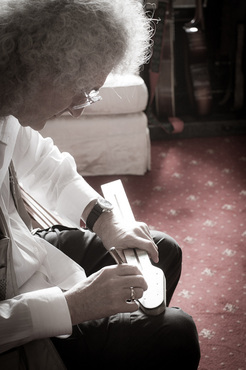 Brian signing one of the 10 green Guytons.
Brian signing one of the 10 green Guytons.
During his time with the prototypes, Brian insisted on hand signing all of the guitars on the headstock face. He was keen for them to have my logo and his signature, so in many years to come people would know what the guitar was and who had built it.
Help from suppliers.
At the time that I started production on the guitars, I was using Andy Blake of Wizard pickups. Andy supplied me with re-worked Kent Armstrong Trisonics. These pickups sounded fabulous, but lacked historic accuracy of construction. This is where Adrian Turner of Adeson pickups comes in. A couple of years after I had started building the replicas, the Trisonics were getting very difficult to get hold of. Kent Armstrong pickups were no longer able to use the name on their pickups. So with a collaboration between Adrian Turner, Greg Fryer and Barry Gibson of Burns UK, the pickups started to become available again with the all important 'Burns Trisonic' logo. This time they were built exactly as they were in the 60's, even down to the thickness of the brass pickup cover. Adrian's workmanship really is second to none, and he continues to supply pickups for the Guyton RS and all the special edition guitars such as the RS doubleneck and the BM Archtop.
As well as pickups, other parts have been upgraded as the original was improved and updated, most obviously, Bourns pots and shaft extenders. This modification was made by Nigel Knight from Knight Audio Developments, who is now Brian's 'go to man' when it comes to anything between the guitar pickups and the amplifier. Nigel's Bourns mod replaces the old Omeg pots with Bourns items....a far higher quality part! To go with these, Nigel designed a stainless steel pot shaft extender. This modification is now fitted as standard to a the Guyton RS guitar.
I'll leave the last word to Brian himself...
Help from suppliers.
At the time that I started production on the guitars, I was using Andy Blake of Wizard pickups. Andy supplied me with re-worked Kent Armstrong Trisonics. These pickups sounded fabulous, but lacked historic accuracy of construction. This is where Adrian Turner of Adeson pickups comes in. A couple of years after I had started building the replicas, the Trisonics were getting very difficult to get hold of. Kent Armstrong pickups were no longer able to use the name on their pickups. So with a collaboration between Adrian Turner, Greg Fryer and Barry Gibson of Burns UK, the pickups started to become available again with the all important 'Burns Trisonic' logo. This time they were built exactly as they were in the 60's, even down to the thickness of the brass pickup cover. Adrian's workmanship really is second to none, and he continues to supply pickups for the Guyton RS and all the special edition guitars such as the RS doubleneck and the BM Archtop.
As well as pickups, other parts have been upgraded as the original was improved and updated, most obviously, Bourns pots and shaft extenders. This modification was made by Nigel Knight from Knight Audio Developments, who is now Brian's 'go to man' when it comes to anything between the guitar pickups and the amplifier. Nigel's Bourns mod replaces the old Omeg pots with Bourns items....a far higher quality part! To go with these, Nigel designed a stainless steel pot shaft extender. This modification is now fitted as standard to a the Guyton RS guitar.
I'll leave the last word to Brian himself...
This GREEN TWIN, as I have begun to call it (it's twin brother is RED) is one of the two prototype BM RED SPECIALS that Andrew Guyton has made. His attention to detail is incredible, and the quality of finish of these guitars is just spectacular. His own skill is unquestionable, and he was aided and abetted by no less than Greg Fryer, who meticulously restored and measured and reproduced my original guitar some years ago to make the one-offs, John, Paul, and George which we so treasure.
Andrew is going into production with these, and though of course they cannot be cheap, with the amount of hand craftsmanship which goes into them, they WILL be the BEST, for the connoisseur!
Brian May.
